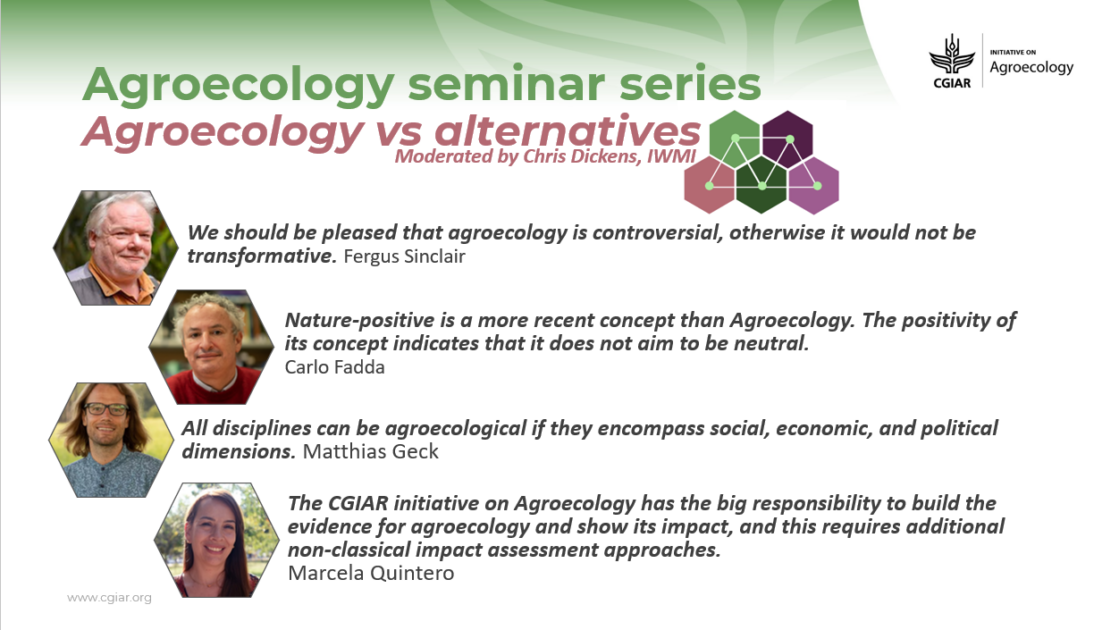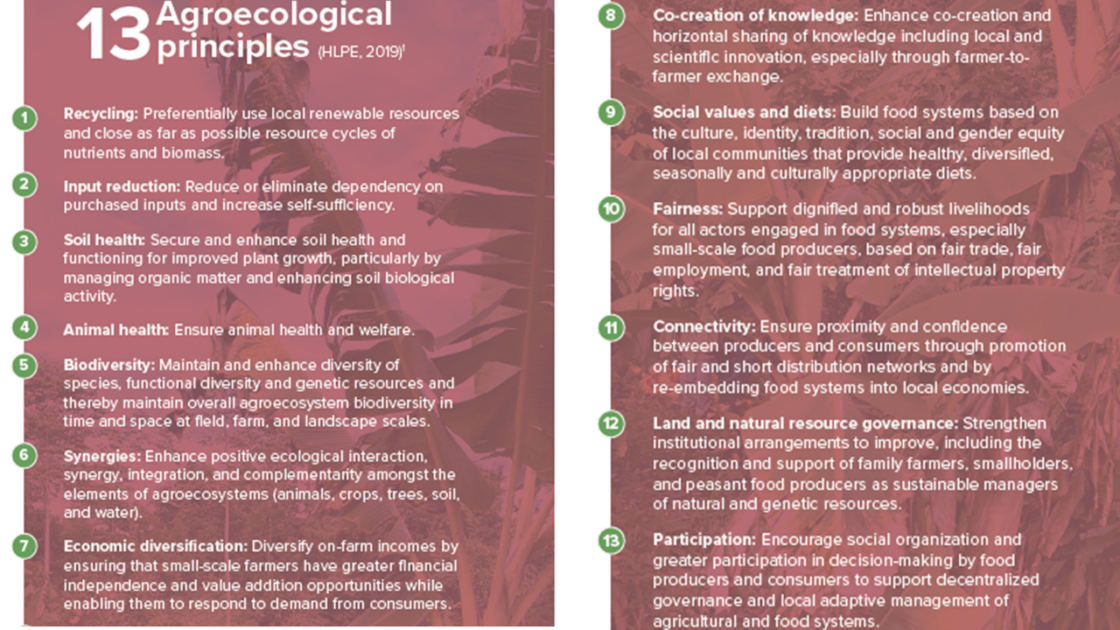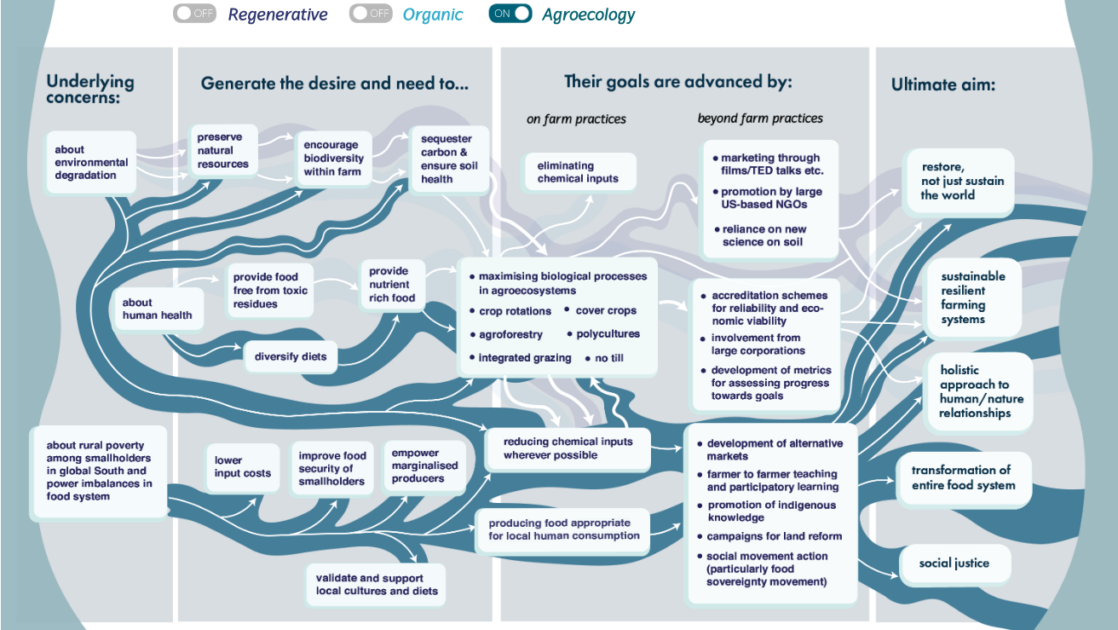Agroecology versus alternative concepts
-
From
CGIAR Initiative on Agroecology
-
Published on
07.12.22
- Impact Area

A first seminar in the series: Foster common understanding of agroecology
Authors: Chris Dickens, co-lead of the CGIAR Initiative on Agroecology and Simone Staiger, senior knowledge manager
A comprehensive undertaking on agroecology as a CGIAR initiative requires a deliberate capacity strengthening effort for its more than 100 collaborating researchers from eight CGIAR centers together with CIFOR – ICRAF, and CIRAD along with partners in seven countries: Burkina Faso, India, Kenya, Laos, Peru, Tunisia, and Zimbabwe.
Indeed, the initiative unites members of different organizations in each of its five research themes so that it has become a priority to provide opportunities to expand and share the knowledge on agroecology among the team and beyond. “This space is designed to tackle core scientific topics with global relevance across countries and research themes related to the design and implementation of the CGIAR Initiative on Agroecology, be they concepts, approaches or methods,” says Bernard Triomphe, a researcher and expert in participatory innovation development from CIRAD. Triomphe, who initially suggested the seminar series, is the leader of Work Package 1 of the Initiative which focuses on the transdisciplinary co-creation of innovations in Agroecological Living Landscapes (ALLs) to test and understand the benefits of agroecological approaches.
The seminars are 1-hour online sessions held twice a month, with short introductions followed by panel discussions that are at least initially tailored to the initiative team members.
Seminar 1: Agroecology versus alternatives
Chris Dickens, principal scientist at the International Water Management Institute (IWMI) and co-leader of the Agroecology Initiative hosted the first seminar. For him “the science of agricultural development has become beset with several seemingly overlapping fields of study that seek to redirect agriculture to greater harmony with the natural environment and to improve the wellbeing of people. Terms such as Agroecology, Nature positive, Nature based solutions, Conservation, Climate Smart, Organic, Regenerative, Sustainable agriculture, etc. all fit into this space, potentially creating confusion not only between scientists but also amongst donors and the public.”

Chris Dickens invited 4 colleagues as discussants:
- Marcela Quintero, Initiative leader; Senior Director, Land and Environment, with the Systems Transformation Global Group of CGIAR; Director of research and Innovation at the Alliance Bioversity-CIAT.
- Fergus Sinclair, Chief Scientist CIFOR-ICRAF
- Matthias Geck, Agroecology Systems Scientist at CIFOR-ICRAF
- Carlo Fadda, Leader of the CGIAR initiative on Nature Positive Solutions, and principal scientist, Biodiversity for Food & Agriculture at the Alliance Bioversity-CIAT
Chris Dickens shared no less than sixteen definitions of Agroecology and some of the many alternatives to illustrate both the commonalities and the differences between these initiatives.
What sets agroecology apart from other alternatives
For Marcela Quintero, agroecology goes beyond the environmental dimension as it aims to understand the social, political, and economic context. People trying to implement agroecology, says Fergus Sinclair “found that socio-economic and governance aspects are critical to transition towards agroecology in order to overcome lock-ins that distort the issue (e.g., subsidies for inputs). Therefore, to achieve comprehensive results, agroecology brings in a more transformative vision that includes the knowledge of other actors including non-scientists.”
Discussants agreed that the reference to the thirteen agroecological principles is foundational as it helps to go beyond conceptual discussions and ensures that all aspects of the system are addressed. The principles are important and were adopted by the Agroecology Coalition. They are universal but can be applied locally. They are normative but not prescriptive. They assure us that the possible negative effects of agriculture on, for example water degradation, are considered, but also that socio-economic aspects and power structures are questioned.
“For me, the explicit emphasis of principles that lie outside of agricultural production is one of the distinguishing features of agroecology and indeed speaks to the importance of a range of factors for fostering transformation.” Frank Place, senior researcher at IFPRI, co-leader of work package 4 on policies

Carlo Fadda presented the CGIAR Initiative on Nature Positive Solutions. He highlighted the important history of agroecology and how many definitions are built on that history. “Nature Positive does not have that history, nor the HLPE structure. The work packages try to create an alternative economic system that opens space for the private sector, and influence how farmers work together,” Fadda said.
All discussants agreed that agroecology as a concept has evolved and that disciplines can be agroecological if they encompass social, economic and political dimensions. “For example, if organic agriculture improves connections among farmers or the political context, then we can consider this organic agriculture experience as agroecological’ said Quintero.
Matthias Geck shared three useful resources:
- This report from the International Panel of Experts on Sustainable Food Systems “Agroecology, Regenerative Agriculture, and Nature-based Solutions”, which emphasizes the need for a social, political and economic revolution.
- This interactive visual (see below) from TABLE (a global platform for knowledge synthesis, for reflective, critical thinking and for inclusive dialogue on debates about the future of food) which explores the ebbs and flows of different agricultural movements including Regenerative, Organic, and Agroecology.
- The visual five levels of food system change “which has been shown so often because it makes clear that most alternatives only work at the agricultural level and coherent formulations for advancing a counter-regime to the current global food system are needed”, says Geck.

Related news
-

Harnessing digital tools in securing soil health for Africa’s food future
Sehlule Muzata27.06.25-
Climate adaptation & mitigation
-
Environmental health
-
Nutrition, health & food security
-
Poverty reduction, livelihoods & jobs
Nairobi, 27 June 2025 (IITA) - As it marks its first anniversary, the Regional Hub…
Read more -
-

Harnessing digital tools in securing soil health for Africa’s food future
Sustainable Farming Science Program27.06.25-
Climate adaptation & mitigation
-
Environmental health
-
Food security
-
Poverty reduction, livelihoods & jobs
Nairobi, 27 June 2025 (IITA) - As it marks its first anniversary, the Regional Hub…
Read more -
-

Raising productivity and profits, How AgWise is Closing Yield Gaps through AI
Sehlule Muzata20.06.25-
Adaptation
-
Climate adaptation & mitigation
-
Environmental health
-
Food security
-
Poverty reduction, livelihoods & jobs
Nairobi, 20 June 2025 (IITA) - Across Africa smallholder farmers battle working with degraded soils,…
Read more -
